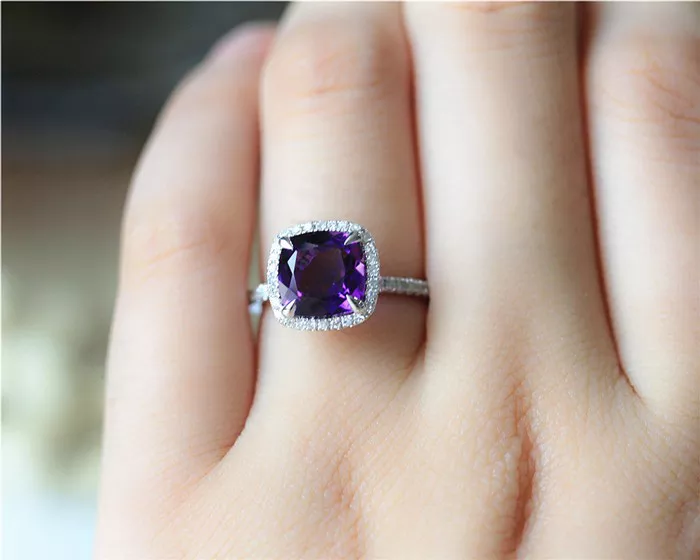Amethyst, with its captivating purple hues, has been cherished throughout history for its beauty and purported metaphysical properties. One of the most popular ways to adorn oneself with this enchanting gemstone is through a ring. But how much is an amethyst ring truly worth? This question encompasses various factors, from the quality of the gemstone to the craftsmanship of the ring setting. In this comprehensive guide, we delve into the intricacies of determining the value of an amethyst ring.
Understanding Amethyst:
Before delving into the valuation of amethyst rings, it’s essential to grasp the characteristics of the gemstone itself. Amethyst is a type of quartz known for its purple coloration, ranging from pale lilac to deep violet. The intensity and uniformity of this color significantly impact the stone’s value. Generally, deeper and more vibrant hues command higher prices, as they are rarer and more desirable.
Factors Affecting Value:
1. Color:
The primary determinant of an amethyst’s worth is its color. Gem-quality amethysts exhibit a rich, saturated purple hue with minimal zoning or color banding. Stones with a pure purple coloration, often referred to as “royal purple,” are the most coveted and consequently fetch higher prices in the market.
2. Clarity:
Like other gemstones, clarity plays a crucial role in determining the value of an amethyst. Ideally, the stone should be transparent to translucent, devoid of any visible inclusions or internal fractures that may detract from its beauty. However, it’s essential to note that certain inclusions, such as reflective needle-like inclusions known as silk, can create unique visual phenomena like asterism, enhancing the stone’s value.
3. Cut:
The cut of an amethyst influences its brilliance, sparkle, and overall appeal. Well-executed cuts maximize the stone’s natural color and clarity while minimizing any undesirable characteristics. Common cuts for amethyst rings include the round brilliant, oval, cushion, and emerald cuts. Custom or unique cuts may command higher prices due to their exclusivity.
4. Carat Weight:
As with most gemstones, the size of an amethyst also impacts its value. Larger stones are generally more valuable than smaller ones, assuming all other factors remain constant. However, it’s essential to consider the interplay between carat weight and color intensity; a smaller stone with exceptional color may be worth more than a larger one with inferior coloration.
5. Origin:
The geographic origin of an amethyst can influence its value and desirability. Certain locales, such as Brazil, Uruguay, and Zambia, are renowned for producing high-quality amethysts prized by gem enthusiasts. Stones from these regions may command premium prices due to their reputation for superior color, clarity, and overall beauty.
6. Treatment:
It’s not uncommon for amethysts to undergo treatment to enhance their color or clarity. Heat treatment, for example, can intensify the purple hue of an amethyst, thereby increasing its market value. However, fully disclosing any treatments is essential for transparency and ethical trading practices.
Valuation Process:
Now that we’ve explored the key factors influencing the value of an amethyst ring, let’s delve into the valuation process itself.
1. Gemstone Appraisal:
The first step in valuing an amethyst ring is to assess the quality of the gemstone itself. This typically involves examining the color, clarity, cut, and carat weight of the amethyst against established grading criteria. Gemologists use specialized tools and techniques to evaluate these characteristics accurately.
2. Market Analysis:
Once the gemstone’s quality has been determined, the next step is to analyze market trends and pricing data for comparable amethyst rings. Factors such as current demand, availability of similar pieces, and recent auction results all play a role in establishing a fair market value for the ring.
3. Craftsmanship Evaluation:
In addition to the gemstone, the craftsmanship of the ring setting must also be considered. Factors such as the quality of the metal (e.g., gold, silver, platinum), intricacy of the design, and presence of any additional gemstones or embellishments contribute to the overall value of the piece.
4. Authentication:
Ensuring the authenticity of both the gemstone and the ring setting is crucial in the valuation process. Certificates of authenticity from reputable gemological laboratories provide assurance regarding the origin, quality, and integrity of the amethyst and any accompanying materials.
Conclusion:
Determining the worth of an amethyst ring requires careful consideration of multiple factors, including the quality of the gemstone, craftsmanship of the setting, market trends, and authentication. By understanding these key elements and engaging with reputable jewelers or gemologists, individuals can make informed decisions when buying, selling, or appraising amethyst rings. Whether as a stunning piece of jewelry or an investment, the allure of an amethyst ring transcends its monetary value, serving as a timeless symbol of elegance and beauty.
FAQs
Are larger amethysts always more valuable?
While size (carat weight) does play a role in determining an amethyst’s value, it’s not the sole determining factor. The color intensity, clarity, and overall quality of the stone also influence its worth. In some cases, smaller stones with exceptional color may be worth more than larger ones with inferior coloration.
Why does the origin of the amethyst matter?
The geographic origin of an amethyst can affect its value and desirability due to differences in color, clarity, and overall quality. Certain regions, such as Brazil, Uruguay, and Zambia, are renowned for producing high-quality amethysts that may command premium prices in the market.
How can I ensure the authenticity of an amethyst ring?
Authenticity can be verified through certificates of authenticity from reputable gemological laboratories. These certificates provide assurance regarding the origin, quality, and integrity of both the amethyst and the ring setting, helping buyers make informed decisions.
Are there different types of cuts available for amethyst rings?
Yes, there are various cuts available for amethyst rings, including the round brilliant, oval, cushion, and emerald cuts, among others. Custom or unique cuts may also be available and may command higher prices due to their exclusivity.

